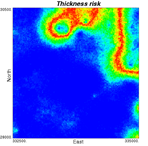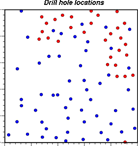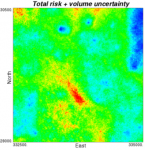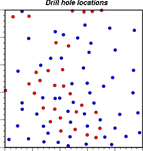Infill drilling
Exploration drilling for resource/reserve definition is commonly carried out on regular patterns, related to resource classification goals, budget constraints, and geological interpretations. Subsequent infill drilling may be required to achieve resource/reserve goals and enhance decision-making under uncertainty. It is during the latter infill drilling phase that an opportunity exists to target the drilling in areas that will contribute more to the reduction of project risk.
In the coal example below, risk involved several factors, including seam and parting thickness, and failure to meet predicted product specifications for ash and sulphur content. For each factor, the residual uncertainty could be calculated for a number of regular drill hole spacings, as shown below.

Infill Drilling Considering Multivariate Risk
Whilst the approach above provides valuable information, the drill hole spacing can vary for each factor under consideration and the budget may not sufficient to drill all the holes required for the desired level of uncertainty.
The Martlet methodology is based on the quantification of risk as established by conditional simulation of the variables in questions. High uncertainty does not necessarily entail high risk if all potential outcomes would result in the same decision. Thus, we can use the law of diminishing returns to focus drill holes in areas of greatest need, as shown below with risk maps and the optimal 30 new drill hole locations.
 |
 |
 |
 |
 |
 |
Low High High |
Historical drill holes Proposed drill holes |
To consider targeting the risk reduction of multiple factors simultaneously, the individual risks can be combined based on user-defined weightings to generate a set of proposed drill holes that matches the budget, as shown below.


Drilling fewer, better located drill holes can save you time and money, and give you more clarity for decision-making.
To discuss how we can help you to achieve this, please contact: Andrew Richmond
View pdf on Locating drill holes to reduce multivariate risk
